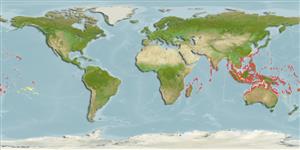Common names from other countries
>
Eupercaria/misc (Various families in series Eupercaria) >
Lethrinidae (Emperors or scavengers) > Monotaxinae
Etymology: Gnathodentex: Greek, gnathos = jaw + latin, dens, dentis = teeth (Ref. 45335).
More on author: Lacepède.
Environment: milieu / climate zone / depth range / distribution range
Ecología
marino asociado a arrecife; no migratorio; rango de profundidad 0 - 30 m (Ref. 9710). Tropical; 30°N - 30°S, 31°E - 134°W
Indo-Pacific: East Africa to the Tuamoto Islands (excluding the Hawaiian Islands), north to Japan, south to Australia. Recently reported from Norfolk Island (Ref. 8880).
Tamaño / Peso / Age
Maturity: Lm ? range ? - ? cm
Max length : 42.3 cm FL macho / no sexado; (Ref. 125599); common length : 20.0 cm TL macho / no sexado; (Ref. 2295); peso máximo publicado: 2.1 kg (Ref. 125599)
Espinas dorsales (total) : 10; Radios blandos dorsales (total) : 10; Espinas anales: 3; Radios blandos anales: 8 - 10.
Inhabits subtidal reef flats, lagoons, and seaward reefs (Ref. 9710). May be solitary or in groups (Ref. 90102). Sometimes forms aggregations of about a hundred or more individuals. Feeds at night on benthic invertebrates like crabs and gastropods, occasionally on small fish. Usually marketed fresh. Minimum depth reported taken from Ref. 128797.
Life cycle and mating behavior
Maturities | Reproducción | Spawnings | Egg(s) | Fecundities | Larva
Carpenter, K.E. and G.R. Allen, 1989. FAO Species Catalogue. Vol. 9. Emperor fishes and large-eye breams of the world (family Lethrinidae). An annotated and illustrated catalogue of lethrinid species known to date. FAO Fish. Synop. 125(9):118 p. Rome: FAO. (Ref. 2295)
IUCN Red List Status (Ref. 130435)
CITES (Ref. 128078)
Not Evaluated
Threat to humans
Reports of ciguatera poisoning (Ref. 4690)
Human uses
Pesquerías: comercial
Herramientas
Special reports
Download XML
Fuentes de Internet
Estimates based on models
Preferred temperature (Ref.
115969): 24.9 - 29.3, mean 28.4 (based on 3356 cells).
Phylogenetic diversity index (Ref.
82804): PD
50 = 1.0000 [Uniqueness, from 0.5 = low to 2.0 = high].
Bayesian length-weight: a=0.01585 (0.00973 - 0.02580), b=3.01 (2.87 - 3.15), in cm Total Length, based on LWR estimates for this species & (Sub)family-body (Ref.
93245).
Nivel trófico (Ref.
69278): 3.7 ±0.57 se; based on food items.
Resiliencia (Ref.
120179): Medio, población duplicada en un tiempo mínimo de 1.4-4.4 años (Preliminary K or Fecundity.).
Fishing Vulnerability (Ref.
59153): Moderate vulnerability (37 of 100).
